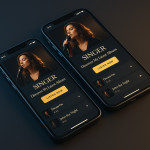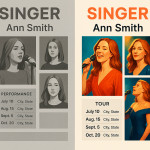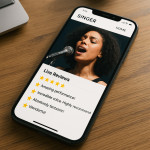Text that resonates: crafting an artist statement for your singer portfolio
A concise, emotionally charged artist statement can turn a casual scroll into a booking inquiry. Learn how to shape words that reinforce your vocal brand, engage casting teams, and amplify discoverability across talent directories.
Why an artist statement matters
Bookers spend barely 20 seconds skimming a new singer profile. Your statement acts as a north-star summary: it signals style, credibility, and personality faster than any showreel. On emerging singer portfolios, listings with a clear statement see up to 35 % more click-throughs to demos, according to internal directory analytics.
Before you write: clarify your brand voice
Define your artistic identity
- Genre focus: Soul, jazz-fusion, EDM topliner? Nail one leading tag and two supporting styles.
- Signature qualities: Four-octave range, bilingual lyrics, improvisation flair—pick traits that solve recruiter pain points.
- Values & story: Grew up in gospel choirs? Highlight roots to add authenticity.
Identify your target opportunities
List the exact gigs you want: sync sessions, cruise-line residencies, or festival headliners. Tailoring language to those audiences helps algorithms match your profile with the right filters—especially when combined with SEO-focused keywords.
Structure of a high-impact singer artist statement
| Section | Word Count | Purpose |
|---|---|---|
| Hook sentence | 10-20 | Instantly show genre & vibe |
| Influences & positioning | 30-40 | Anchor sound in recognizable context |
| Proof points | 40-50 | Highlight credits, audience metrics, awards |
| Future vision & CTA | 20-30 | Invite specific bookings or collaborations |
1 — Hook sentence
Open with a vivid snapshot: “Velvet-toned jazz vocalist blending French chanson with neo-soul grooves.” The recruiter understands genre, texture, and uniqueness in 12 words.
2 — Core influences & genre positioning
Name two well-known references and one surprising twist: “Think Erykah Badu meets Norah Jones, seasoned with Afro-Latin percussion.” You signal versatility without sounding derivative.
3 — Achievements & proof
Replace vague boasts with numbers: “1.2 M Spotify streams, BBC Introducing Artist of the Week, and sold-out support slots for Gregory Porter.” Data elevates trust, mirroring the effect of verified credibility badges.
4 — Future direction & booking CTA
End with momentum: “Currently booking 2025 festival dates and sync vocals for cinematic neo-soul scores—let's collaborate.” You leave no doubt about next steps.
Tone, length and style guidelines
- 100–140 words: Long enough for substance, short enough for mobile skims.
- Active verbs: “Ignites,” “weaves,” “elevates.” Avoid passive filler.
- Second person benefit: Shift from “I” to “You'll get a voice that…” to spotlight client gains.
- No genre clichés: Retire “music is my life.” Replace with concrete imagery.
Step-by-step writing process
- Free write (10 min): Dump influences, milestones, and goals without editing.
- Highlight essentials: Circle items that serve your booking objectives.
- Draft structure: Slot points into the four sections above.
- Trim adjectives: Replace three words with one concrete noun wherever possible.
- Read aloud: If it sounds unnatural, rewrite until it flows like spoken language.
- Peer review: Swap with a trusted singer or use profile optimisation peers for feedback.
- Update quarterly: Align with new releases, awards, or vocal training milestones.
Real-world examples
| Line | Bland Version | Resonant Upgrade |
|---|---|---|
| Hook | “I love singing soulful music.” | “London-based contralto blending Motown warmth with lo-fi electro beats.” |
| Influences | “Inspired by many artists.” | “Channels the storytelling of Tracy Chapman and the rhythmic daring of FKA twigs.” |
| Proof | “Performed at several venues.” | “Headlined the 4 000-seat Jazz Café Festival and reached #3 on UK Viral chart.” |
| CTA | “Contact me for gigs.” | “Seeking sync collaborations for indie films and summer festival slots—let's talk.” |
Optimising your statement for SEO and directories

In talent databases, text fields fuel search filters. Combine your primary keyword—soul singer artist statement—with secondary modifiers (city, vocal range, languages). Pair this copy with mobile-ready layouts so the statement displays above the fold on every device. Remember, search engines reward clarity; avoid keyword stuffing and lean into natural, reader-friendly phrasing that mirrors how scouts actually search for talent, ensuring your profile surfaces in both broad and niche discovery scenarios across booking platforms.
Placement tips
- Above demo player: Users process text faster than audio snippets.
- Alt attribute: Mirror your hook line in the alt text of your hero image for extra relevance.
- Meta description: Paste a trimmed 155-character version to win rich-snippet clicks.
Common pitfalls to avoid
- Overstuffed buzzwords: “Dynamic passionate unique” means nothing without context.
- Long career backstories: Recruiters rarely care about childhood choirs—focus on current market fit.
- Generic CTAs: “Contact me anytime” feels needy. State the exact projects you're open to.
- Out-of-date metrics: Replace that 2019 YouTube view count with fresh Spotify stats.
Quick self-check quiz
FAQ
- How often should I update my artist statement?
- Quarterly, or immediately after major milestones like chart placements or award wins.
- Can I reuse the same statement across platforms?
- Yes, but tweak keywords and CTAs to match each platform's audience and filter system.
- What if I perform in multiple genres?
- Create one umbrella statement highlighting versatility, then add micro-blurbs for each genre page.
- Should I mention vocal training or degrees?
- Only if they add market value—e.g., classical training that supports session reliability.
- Is humor appropriate?
- Sparingly. A clever line can showcase personality, but avoid jokes that obscure clarity.
Ready to sing it out?
Your voice already turns heads; let your words do the same. Draft your statement today, embed it atop your portfolio, and watch booking inquiries climb. Need an outside eye? Share your draft with a peer, iterate, and post before your next release cycle.











